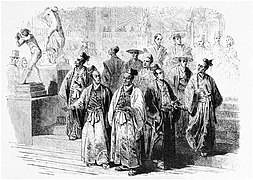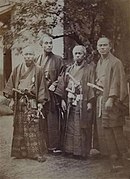Takenouchi Mission
The Takenouchi Mission ( Japanese 文 久 遣 欧 使節 , Bunkyū ken-Ō shisetsu) was sent to Europe by the Japanese shogunate in 1862. It is named after the formal head of the mission Takenouchi Yasunori (竹 内 保 徳; 1807-1867), governor of Shimotsuke Province (now Tochigi Prefecture ). Shibata Takenaka (柴 田 剛 中; 1823–1877) worked under him as the actual leader. The mission consisted of 40 people, including Fukuzawa Yukichi as one of the two interpreters.
getting there
The mission left the port of Shinagawa (near Tōkyō) on January 23, 1862 on the English warship "Odin", which brought them to Valletta in Malta. On March 4th they boarded the English steamer “Himalaya” and reached France in Marseille.
France, England and the Netherlands
The embassy reached Lyons on April 5th and Paris on April 7th, where they stayed at the Hotel de Louvre. The French Foreign Minister received the delegation on April 9th and Emperor Napoleon III. with his wife on the 13th, this reception being initiated by a military parade. The embassy visited the artillery museum, felt at home in Paris and was reluctant to continue their journey.
After a stay of 26 days, the embassy continued its voyage on April 29th, crossing the English Channel on board the state ship "Corse" and reaching England. In London, on April 30th, the Japanese flag was hoisted at Claridge's Hotel. Foreign Minister Earl Russel visited the legation on May 2, and the following day the legation attended the opening of the World's Fair . During their 43-day stay, the legation visited the parliament building, the zoological garden, military, economic, technical and medical facilities.
The Dutch warship "Arturo" brought the embassy to Rotterdam on June 14th, where it was warmly welcomed by the population. She then traveled on to The Hague . On July 1st, King Wilhelm III. the embassy and gave her dinner on July 7th. In the negotiations, the Dutch, like the British, pressed for the opening of some ports in Japan as soon as possible. After a stay of 34 days, the embassy, disappointed by the unexpectedly unfriendly treatment, traveled on to Germany.
Germany
The embassy traveled from the Netherlands to Germany. The year before, Count Friedrich zu Eulenburg was able to conclude a friendship and trade treaty between Japan and Prussia as a result of the Prussian East Asia Expedition in Edo , so that the first return visit was made. A number of personalities from Berlin arrived on July 13th to receive the legation in Cologne on July 17th.
On the evening of July 18, the delegation arrived in Berlin, where they were officially received at Potsdamer Bahnhof. She was accommodated in the "Hotel de Brandenbourg", where Count Eulenburg had already reserved rooms from Holland. King Wilhelm I traveled from Babelsberg to Berlin on July 21st, and standing in front of the throne he received the delegation in the White Hall of the Berlin Palace. After receiving them in the palace, the embassy went to the royal palace, where they were received by Queen Augusta .
In the next few days, factories and military workshops were visited, but military facilities were not visited. The legation attended a session of the House of Representatives. Envoys from other countries were also visited in Berlin, but only those with whom Japan had concluded treaties. The population showed great interest in the Japanese dressed in local costume.
The Hanseatic cities used the presence of the Japanese embassy in Berlin to emphasize their wish to be included in the treaty concluded with Prussia. The embassy itself was unable to do this, and other attempts also failed. So it could not be enforced that the German Louis Kniffler , owner of the company L. Kniffler & Co., Nagasaki, took over a representation that was recognized by the Japanese side.
Russia
After only 17 days in Germany, the embassy traveled on to Russia on August 5th, where it arrived in St. Petersburg on August 9th . On August 14th she received Tsar Alexander III. in the throne room of the Winter Palace and emphasized the friendly relations between the two countries that meet in the Far East. However, in 1861 the Russian Empire wanted to annex the strategically important island of Tsushima , a project that they failed to do after the British government protested.
Return journey
After a stay in Russia of a good month, the delegation returned to Germany and arrived in Berlin on September 19. She traveled on - this time unnoticed - after two days. The journey continued via France and Spain to Portugal. On November 24th she embarked in Suez on the French transport ship "L'Européen". The ship reached Ceylon on December 17th and Singapore in early January 1863. Japan was reached in late January.
Post Comment
Fukuzawa published after his return in 1867 under the title "Conditions in the West" (西洋 事情, Seiyō Jijō) his experiences on the trip to Europe and the previous USA trip in 1860. Probably due to lack of time, he decided not to carry out the planned chapter on Prussia.
photos
Visit to the World Exhibition in London
- ^ Members of the first embassy to Europe in 1862. Sitting in the middle Shibata Takenaka.
- ↑ From the Illustrated London News .
- ↑ Fukuzawa Yukichi is second from left.
Individual evidence
- ↑ Illustrated in the Illustrierte Zeitung on August 9, 1862.
See also
literature
Georg Kerst: The Japanese special embassy to Europe in 1862. Yearbook of the historical society Bremen. Carl Schünemann, Bremen. 1971.





